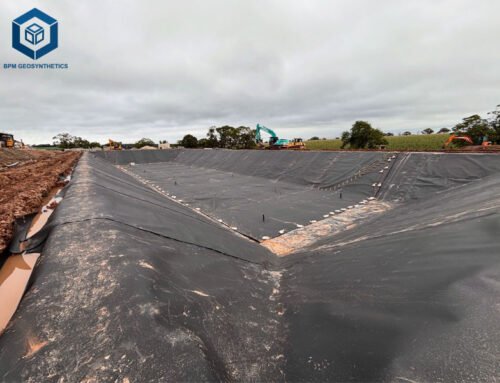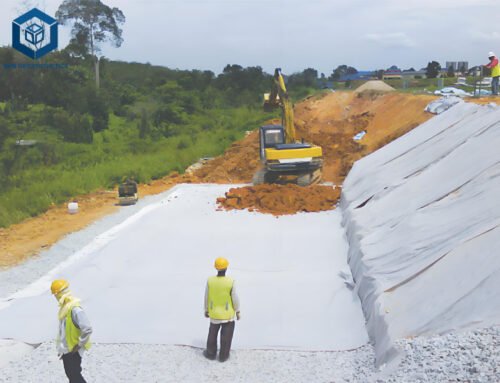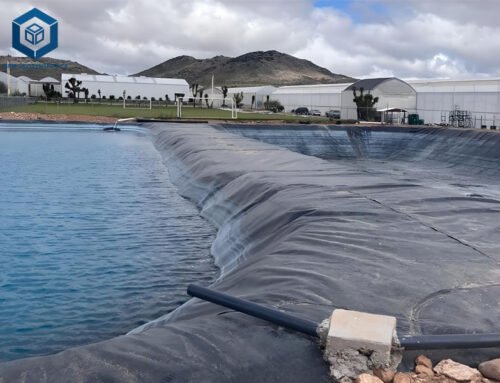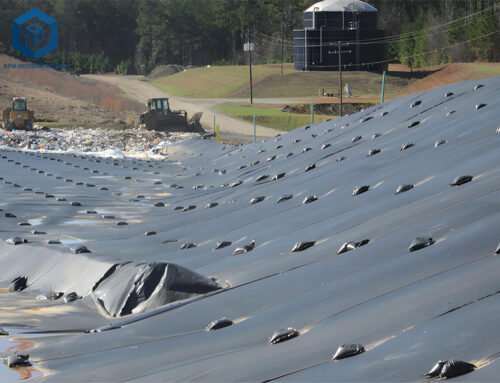Geomembranes and geogrids are pivotal geosynthetic materials in civil engineering, each engineered for distinct purposes yet often misunderstood or misapplied. Geomembranes serve as impermeable barriers to prevent fluid migration, while geogrids provide structural reinforcement to enhance soil stability. With the global geosynthetics market valued at USD 14.6 billion in 2024 and projected to grow at a CAGR of 6.2% through 2030 (MarketsandMarkets, 2024), selecting the appropriate material is crucial to avoid project failures, such as 15–20% higher maintenance costs or 10–15% reduced structural lifespan (Geosynthetics Magazine). This blog post delves into the Differences of Geomembrane vs Geogrid, offering detailed specifications, applications, performance parameters, and recent trends. This guide empowers engineers, contractors, and project managers to make informed decisions for infrastructure and environmental projects.
1. What Is a Geomembrane?
Definition and Purpose
A geomembrane is a low-permeability synthetic liner designed to block the migration of liquids or gases, acting as a robust barrier in containment applications. Typically made from high-density polyethylene (HDPE), linear low-density polyethylene (LLDPE), or polyvinyl chloride (PVC), geomembranes achieve permeability rates as low as 1×10^-11 cm/s, preventing 98–99% of fluid seepage (ASTM D5887). Their primary role is to ensure environmental protection and water retention in high-stakes projects.
Key Features
- Material Composition: HDPE (65% market share), LLDPE (20%), PVC (10%), with 97.5% polymer and 2.5% stabilizers like carbon black .
- Thickness: 0.5–3.0 mm, with 1.0–2.0 mm common for landfills (ASTM GRI-GM13).
- Tensile Strength: 18–60 MPa, with 600–900% elongation at break (ASTM D6693).
- Durability: Lasts 50–100 years buried, 10–20 years exposed without UV stabilizers (shyfgeo.com).
- Installation: Requires hot-air or extrusion welding for seams, achieving 85–95% strength (ASTM D6392).
Common Uses
- Landfills: Prevents 98% of leachate leakage, safeguarding groundwater (Geosynthetics Magazine).
- Aquaculture Ponds: Ensures 95% water retention, lasting 50+ years buried .
- Mining Tailings: Contains 99% of toxic effluents, with textured surfaces for 30° friction angles (IMARC Group).
- Reservoirs and Canals: Reduces seepage by 95%, enhancing water conservation (usbr.gov).
- Wastewater Lagoons: Blocks 99% of contaminant migration .
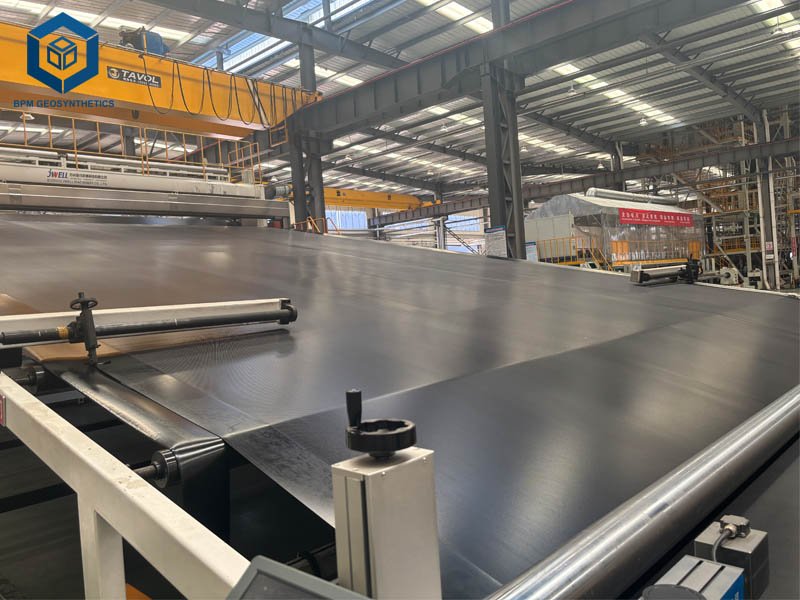
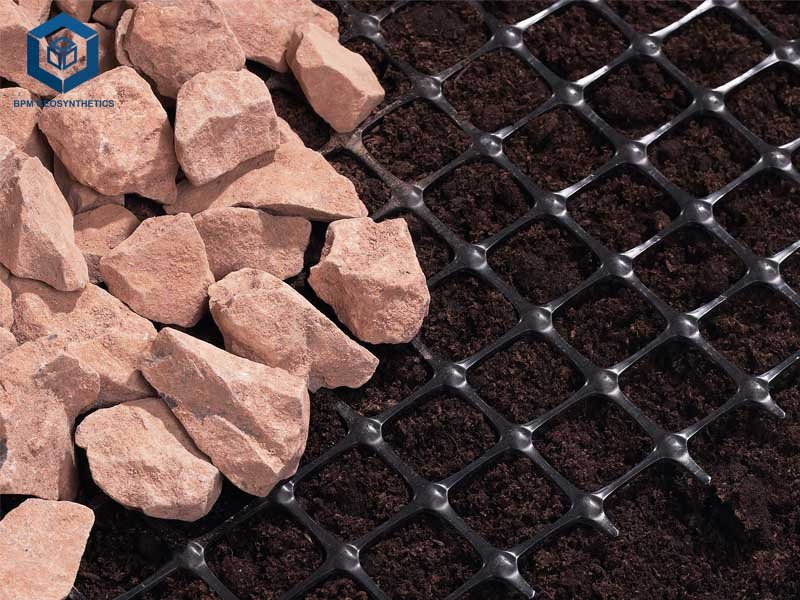
2. What Is a Geogrid?
Definition and Purpose
A geogrid is a high-strength, open-grid polymeric structure designed to reinforce soils and aggregates by interlocking with surrounding materials, improving load-bearing capacity by 20–30% (Civil Engineering Journal). Made from HDPE, polypropylene (PP), or polyester (PET), geogrids are used for soil stabilization and reinforcement, with tensile strengths ranging from 20–400 kN/m (ASTM D6637). Their open structure allows soil interaction, making them ideal for structural applications.
Key Features
- Material Composition: HDPE (40%), PP (30%), PET (25%), often coated for UV resistance .
- Grid Aperture: 10–100 mm, optimizing soil interlock (Tensar data).
- Tensile Strength: 20–400 kN/m, with 10–20% elongation (ASTM D6637).
- Durability: Lasts 20–120 years buried, 5–15 years exposed without coatings (library.geosyntheticssociety.org).
- Installation: Laid and anchored with minimal overlap, reducing labor by 15% compared to geomembranes (geosynthetics.textiles.org).
Common Uses
- Road Construction: 50% of demand, reducing base thickness by 15–30% and extending pavement life by 20% (rosap.ntl.bts.gov).
- Retaining Walls: Enhances stability by 25%, minimizing lateral movement (Geosynthetics Magazine).
- Slope Stabilization: Increases shear strength by 20–30%, preventing 25–50% of erosion (Tensar data).
- Railway Embankments: Improves load distribution by 30%, reducing settlement .
- Foundation Reinforcement: Boosts bearing capacity by 15–20% in soft soils (link.springer.com).
3. Key Differences of Geomembrane vs Geogrid
3.1 Differences of Geomembrane vs Geogrid – Material Composition
- Geomembrane: HDPE, LLDPE, or PVC, with 97.5% polymer and 2.5% stabilizers for chemical and UV resistance .
- Geogrid: HDPE, PP, or PET, with open-grid structures for soil interlock, often coated for durability .
3.2 Differences of Geomembrane vs Geogrid – Permeability
- Geomembrane: Impermeable (1×10^-11 cm/s), blocking 99% of fluid flow for containment (ASTM D5887).
- Geogrid: Fully permeable due to open-grid design, allowing 100% water passage, unsuitable for containment.
3.3 Differences of Geomembrane vs Geogrid – Structure and Function
- Geomembrane: Continuous sheet for fluid barrier, with smooth or textured surfaces for friction.
- Geogrid: Grid-like structure for soil reinforcement, interlocking with aggregates to enhance stability .
3.4 Differences of Geomembrane vs Geogrid – Mechanical Strength
- Geomembrane: Tensile strength of 18–60 MPa, with high elongation (600–900%) for flexibility under stress (ASTM D6693).
- Geogrid: Tensile strength of 20–400 kN/m, with lower elongation (10–20%), optimized for rigid reinforcement (ASTM D6637).
3.5 Differences of Geomembrane vs Geogrid – Durability
- Geomembrane: Lasts 50–100 years buried, 10–20 years exposed without UV stabilizers, resisting 90% of pH 2–12 exposures (shyfgeo.com).
- Geogrid: Lasts 20–120 years buried, 5–15 years exposed, with creep deformation a concern for long-term loads (library.geosyntheticssociety.org).
3.6 Differences of Geomembrane vs Geogrid – Installation
- Geomembrane: Requires skilled welding for seams, with installation costs of $0.50–$1.50/m², taking 20–30% longer due to precision needs (ASTM D6392).
- Geogrid: Laid with minimal overlap and anchored, with installation costs of $0.30–$1.00/m², faster by 15–20% (geosynthetics.textiles.org).
3.7 Differences of Geomembrane vs Geogrid – Cost
- Geomembrane: $1.00–$3.00/m², with HDPE at $1.50–$2.50/m², higher due to impermeable properties .
- Geogrid: $0.50–$2.50/m², with PP at $0.75–$1.50/m², 20–30% cheaper due to simpler manufacturing .
4. Detailed Specifications and Performance Parameters
Geomembrane Specifications
- Material: HDPE (97.5% polyethylene, 2.5% carbon black), LLDPE, or PVC .
- Thickness: 0.5–3.0 mm, with 1.0–2.0 mm for landfills (ASTM GRI-GM13).
- Tensile Strength: 18–60 MPa (ASTM D6693).
- Elongation at Break: 600–900% (ASTM D6693).
- Puncture Resistance: 200–1,000 N (ASTM D4833).
- UV Resistance: 70–90% strength retention after 500 hours (ASTM D4355).
- Permeability: 1×10^-11 cm/s (ASTM D5887).
- Friction Angle: >30° with geotextiles (ASTM D5321).
- Certifications: ISO 9001, ISO 14001, GRI-GM13, GRI-GM17 (solmax.com).
Geogrid Specifications
- Material: HDPE, PP, or PET, often coated for UV resistance .
- Aperture Size: 10–100 mm, optimizing soil interlock (Tensar data).
- Tensile Strength: 20–400 kN/m (ASTM D6637).
- Elongation at Break: 10–20% (ASTM D6637).
- Creep Resistance: <5% deformation after 1,000 hours at 50% load (ISO 13431).
- UV Resistance: 70–90% strength retention after 500 hours (ASTM D4355).
- Junction Strength: 80–95% of tensile strength (ASTM D7737).
- Certifications: ISO 9001, ASTM, AASHTO M288 (rosap.ntl.bts.gov).
Performance Comparison
- Hydraulic Performance: Geomembranes block 99% of fluid flow, while geogrids are permeable, unsuitable for containment (ASTM D5887).
- Mechanical Strength: Geogrids provide 20–30% higher reinforcement strength, while geomembranes offer 30% better puncture resistance (ASTM D4833, ASTM D6637).
- Durability: Geomembranes excel in chemical resistance (90% for pH 2–12), while geogrids face creep risks, losing 5–10% strength under sustained loads (library.geosyntheticssociety.org).
- Stress Cracking: HDPE geomembranes and geogrids are tested for stress crack resistance, with geomembranes retaining 80% strength after 500 hours versus 70% for geogrids (cedengineering.com).
5. Applications: Where Each Material Excels
Geomembrane Applications
- Landfill Liners: HDPE geomembranes (1.5–2.0 mm) prevent 98% of leachate leakage, often paired with geotextiles for protection .
- Aquaculture Ponds: Smooth HDPE (0.75–1.0 mm) ensures 95% water retention, lasting 50+ years .
- Mining Tailings: Textured HDPE (2.0 mm) contains 99% of effluents, with 30° friction angles for slope stability (IMARC Group).
- Reservoirs: LLDPE geomembranes (1.0–1.5 mm) reduce seepage by 95% (usbr.gov).
- Hazardous Waste Containment: PVC geomembranes block 99% of chemical migration .
Geogrid Applications
- Road Construction: Biaxial PP geogrids (20–100 kN/m) reduce pavement thickness by 15–30%, lasting 20–120 years (rosap.ntl.bts.gov).
- Retaining Walls: Uniaxial PET geogrids (100–400 kN/m) enhance stability by 25% (Geosynthetics Magazine).
- Slope Stabilization: Biaxial HDPE geogrids increase shear strength by 20–30%, preventing 25–50% of erosion (Tensar data).
- Railway Embankments: Geogrids improve load distribution by 30%, reducing settlement by 15% .
- Soft Soil Foundations: Geogrids boost bearing capacity by 15–20% (link.springer.com).
Combined Applications
- Landfill Systems: Geomembranes provide containment, while geogrids reinforce underlying soils, improving stability by 20% (geofabricsmining.com.au).
- Pond Liners: Geomembranes ensure impermeability, with geogrids stabilizing subgrades, reducing settlement by 15% .
- Mining: Geogrids reinforce tailings dam foundations, while geomembranes contain effluents, enhancing safety by 20% (IMARC Group).
6. Cost Comparison
- Geomembrane: $1.00–$3.00/m², with HDPE at $1.50–$2.50/m² and LLDPE at $1.00–$2.00/m². Installation adds $0.50–$1.50/m² .
- Geogrid: $0.50–$2.50/m², with PP at $0.75–$1.50/m² and PET at $1.00–$2.50/m². Installation adds $0.30–$1.00/m² .
- Combined Systems: Geomembrane-geogrid systems cost $2.00–$5.00/m² but enhance stability and containment, saving 20–30% on maintenance .
Geogrids are 20–30% cheaper, but geomembranes justify higher costs for containment with 50–100-year lifespans versus 20–120 years for geogrids (shyfgeo.com).
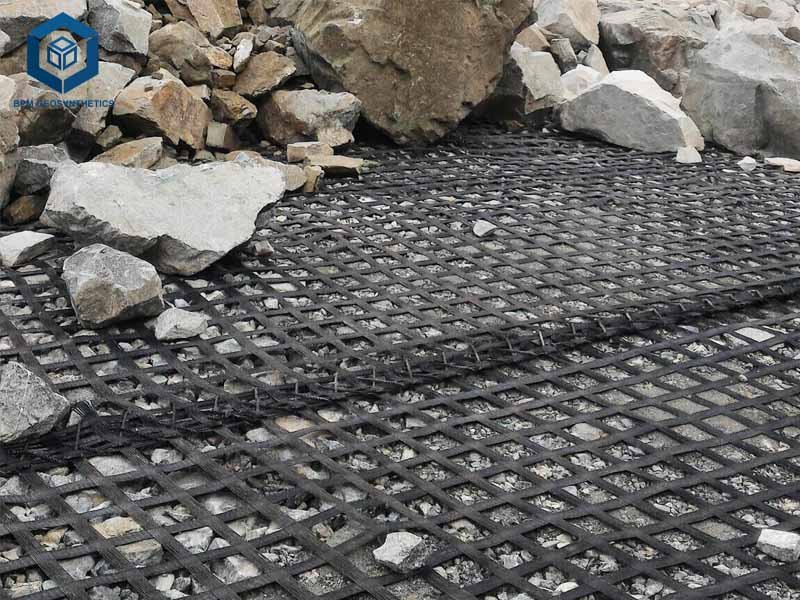
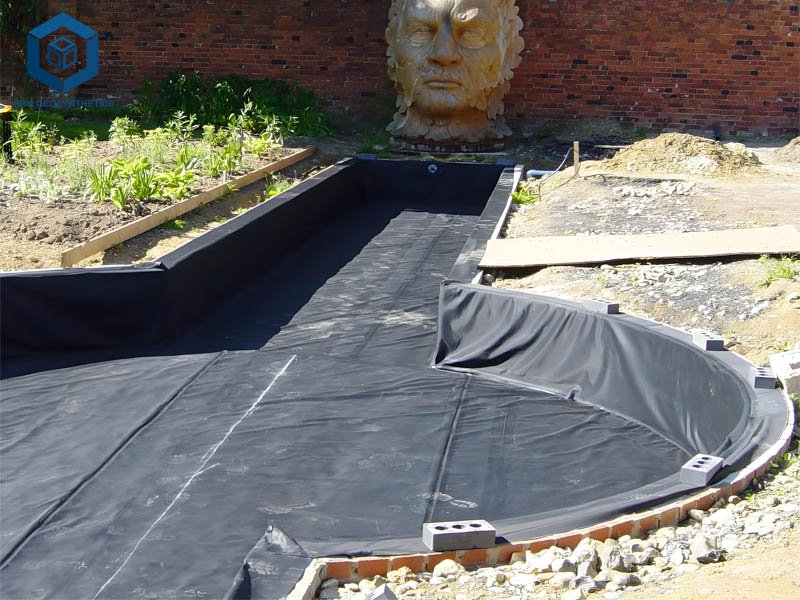
7. Choosing Differences of Geomembrane vs Geogrid
When to Choose Geomembrane
- Containment Needs: Landfills, ponds, or mining require 99% impermeability (epa.gov).
- Chemical Exposure: HDPE resists 90% of pH 2–12 conditions.
- Long-Term Durability: Buried applications needing 50–100 years of service (shyfgeo.com).
- Regulatory Compliance: EPA or ASTM standards mandate fluid barriers (EPA Guidelines).
When to Choose Geogrid
- Soil Reinforcement: Roads, slopes, or foundations need enhanced stability (link.springer.com).
- Cost Constraints: Projects with 20–120-year lifespans and lower budgets .
- Load Distribution: High-traffic areas require 20–30% better load-bearing capacity (rosap.ntl.bts.gov).
- Erosion Control: Slopes or embankments need 25–50% erosion reduction (Tensar data).
Combined Use
For complex projects like landfills or mining, use geomembranes for containment and geogrids for soil reinforcement, improving system performance by 20–30% .
8. Case Studies: Geomembrane vs. Geogrid
Landfill Project (USA, 2022)
A Texas landfill used 1.5 mm HDPE geomembranes ($2.00/m²) for containment and biaxial PP geogrids ($1.00/m²) for foundation reinforcement. The system reduced leakage by 98% and improved stability by 20%, lasting 50–100 years.
Highway Construction (India, 2023)
A highway project used uniaxial PET geogrids (200 kN/m, $1.50/m²) for subgrade reinforcement, reducing pavement thickness by 20% and lasting 20–120 years. Geomembranes were unsuitable due to permeability needs.
Mining Tailings (Australia, 2024)
A gold mine used 2.0 mm textured HDPE geomembranes ($2.50/m²) for effluent containment and HDPE geogrids ($1.20/m²) for dam reinforcement, achieving 99% containment and 25% stability improvement.
9. Conclusion
Geomembranes and geogrids are essential geosynthetics with distinct roles: geomembranes provide 99% impermeability for containment in landfills, ponds, and mining, lasting 50–100 years at $1.00–$3.00/m², while geogrids offer 20–30% soil reinforcement for roads, slopes, and foundations, lasting 20–120 years at $0.50–$2.50/m². Their specifications—geomembranes with 18–60 MPa tensile strength and 1×10^-11 cm/s permeability, versus geogrids with 20–400 kN/m strength and open-grid design—dictate their applications. Recent trends like conductive geomembranes, smart geogrids, and recycled materials enhance performance by 10–20%, while combined systems optimize complex projects.
For engineers and contractors, selecting between geomembranes and geogrids depends on project goals, environmental conditions, and budget. Partnering with suppliers like BPM Geosynthetics ensures access to ASTM-compliant materials. By understanding these differences and leveraging innovations, professionals can deliver cost-effective, durable solutions and beyond.


